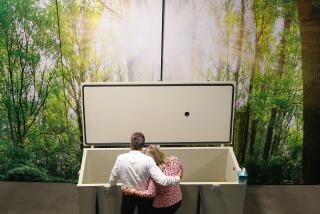Utah Group Resurrects the Art of Mummifying
SALT LAKE CITY — If burial sounds boring and cremation leaves you cold, here’s another idea: mummification.
Why not? It was good enough for King Tut.
We’re talking high-tech interment, a combination of ancient art and tomorrow’s science--for a price. The basic procedure costs $63,000 or more, according to the Salt Lake City religious group Summum, and there’s little use in shopping around.
“We’re the only ones worldwide that do modern mummification,” said Corky Ra, Summum’s founder and leader.
It sounds bizarre, but mummification is just one of a range of options for those who don’t want to go out the old-fashioned way.
“There has been a trend in funeral service over the past decade or so toward more personalized and individualized funeral service rituals,” said Kelly Smith, spokesman for the National Funeral Directors Assn.
There are burials at sea and burials in space, chrome-edged caskets for Harley-Davidson buffs and coffins customized with computer software. The ashes of the dearly departed can be dropped from a plane or a hot-air balloon, entombed in a coral reef or used to grow a bonsai tree.
At the farthest end of the spectrum is mummification, which Summum started researching in 1979, practicing on 30 cadavers contributed by a local medical school.
Summum’s method is a bit more advanced than traditional mummification, which involved a salt-like preservative called natron and yards and yards of linen.
These days, in a warehouse behind the gleaming metal pyramid Summum uses for its services, modern-day mummies are cleaned inside and out and drained of blood before being soaked for up to six months in a vat of preservation fluid that Ra calls his “secret formula.” Afterward, the corpse is covered with lanolin and wrapped with gauze.
Then comes a dozen coats of polyurethane rubber, which dries as tough as a tire. Next are layers and layers of fiberglass bandages, which are used to set the body in the desired position. A bronze mummiform much like those found in the ancient pyramids provides the final layer of protection, and the body is sealed inside with a resin.
Ra got a patent for the procedure, and in 1985 showed off his creation at a national funeral directors’ convention in Las Vegas. The reaction was chilly.
“Getting a funeral director to do something different is like moving a mountain,” Ra said. “And this is really different.”
But that attitude has changed in recent years as cloning has come within reach. Scientists are now working to reclaim genetic material from Egypt’s millennia-old mummies--and Ra claims his procedure has the same potential for conservation.
“People started to look at it differently, especially in the funeral industry, to the extent that we have a lot of people calling us now saying, ‘Hey, maybe I can have my DNA preserved.’ ”
There’s little scientific evidence to back up that statement, although Ra boasts that one of his first subjects--a cat named Oscar--was unwrapped 10 years after being mummified and found in perfect condition, right down to the lenses in his eyes.
That’s plenty of proof for some. About 25,000 people have contacted Summum to find out more, most of them via the Internet, and 137 have paid in advance to be mummified, Ra said, although no one has actually used the service.
“The people that consider being mummified do it for a lot of different reasons,” said Gracey Ra, Corky’s wife. “Some of them do it because they don’t like the options. Some do it because they think they’ve done something so important in life they want to leave a monument of their accomplishments.”
Others, including the Ras themselves, believe that mummification and the ceremony Summum practices along with it help to ease the spirit’s transition into the afterlife. That’s part of Summum’s general philosophy, which incorporates aspects of every organized religion into a sort of new-age spirituality that includes meditation, science fiction and reincarnation.
Sue Menu, who leads a meditation class, chose to sign up for mummification 10 years ago.
“It just felt like it was what I wanted to have done,” she said. “To be honest, I hadn’t really thought much about it because I was fairly young and I hadn’t really even thought about death.”
Since then, she has had her poodle, Maggie, mummified and is still waiting to get the body back. Several other pets stand guard inside the pyramid: a Doberman pinscher named Butch, a cat done in traditional Egyptian style and a 180-pound mastiff still in progress.
Summum, a nonprofit organization, charges $9,000 to mummify a cat and $20,000 for a dog. People cost far more. Summum charges $12,000 for the basic mummification process, plus $36,000 for the simplest bronze mummiform. Then there’s the cost of shipping a body to Salt Lake City, about $5,000; and funeral arrangements and mausoleum space, which the group estimates at $5,000 or more each.
The average traditional funeral, on the other hand, costs about $7,000, including burial. Direct cremation--without an urn, burial or funeral service--costs $1,100 to $1,500, according to the funeral directors’ association.
“The advantage to mummification unravels when you compare prices,” Smith said.
But the cost hasn’t kept away customers. Instead, Ra likes to joke that everyone who signs a contract seems to live forever.
“People always ask, ‘When is your first person going to die so you can mummify them?’ ” Ra said. “All of our people are in really good health. I don’t know anybody even near death.”
*
On the Net:
www.summum.org/mummification
National Funeral Directors Assn.:
www.nfda.org
For links to offbeat funeral options:
www.cheekyfunerals.com
More to Read
Sign up for Essential California
The most important California stories and recommendations in your inbox every morning.
You may occasionally receive promotional content from the Los Angeles Times.










